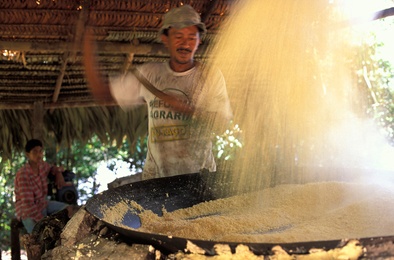Learn about the Amazonian ‘Casa de Farinha’

The flour house (casa de farinha, in Portuguese) is the place where cassava becomes flour, an ingredient used in the manufacture of various foods from the North and Northeast of Brazil. The raw material for making cassava flour (jatropha manihot) is a plant of the Euphorbia family, a well-known tuber grown and traditionally used by Brazilian natives in food products.
The flour house consists of a grating system, a pressing system and an oven. After the root is harvested, the cassava is taken straight from the field to the flour house, where it is peeled or scraped to remove dark and dirty skin. It is then crushed or grated in a pestle or grater (caititu). The grated cassava is then dropped into a trough, then pressed into a cylindrical straw basket (tipiti) to remove a poisonous liquid called ‘manipuera’ or ‘manipueira’, commonly called manioc water, which is the result of fermentation. It also helps to dry out the dough. Once sifted and toasted, the flour is ready for consumption.
Cassava flour is also a good source of vitamin B6, manganese, magnesium and iron. Cassava flour can be a great food for those who need fast energy for their activities. Because it is rich in carbohydrates, it rapidly converts to glucose, the essential fuel for all body processes such as muscle contraction and recovery.
It is low in fat and it is a source of fibers. It is also gluten-free and a source of tryptophan and vitamin B6, two of the nutrients needed for serotonin production.
Guests at Xixuaú Amazon Ecolodge can visit the local ‘casa de farinha’ and watch how this important, nutritious ingredient is manufactured.
Related Posts
-
-
We step on it, we deforest it and we exploit it, but we can ...Dec 05, 2020 / 0 comments
-
«I like talking about commercialization of the beauty of th...Dec 14, 2019 / 0 comments
-
Due to the pandemic, our ecolodge is not operating at the m...Sep 25, 2021 / 0 comments
Contact us
Xixuaú Amazon Ecolodge
69373-000 – RR, Brasil






Sorry, the comment form is closed at this time.